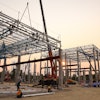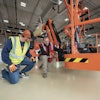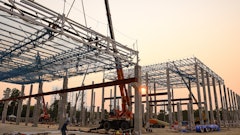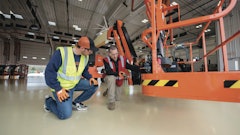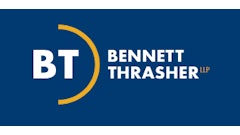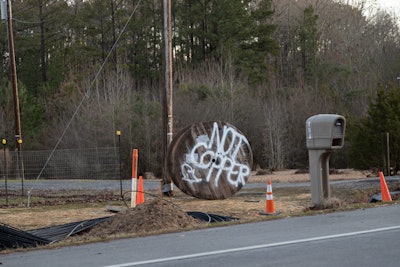
Theft is a phenomenon that follows the news cycle. In a year marked by economic uncertainty and seismic changes in international trade, thieves have taken notice. Increasingly, they see opportunity on construction sites.
With the August 1, 2025 rollout of 50% tariffs on semi-finished copper products entering the U.S., construction sites have suddenly become more desirable targets. What used to be simple materials — wiring, HVAC components, plumbing — has suddenly accrued higher theft value on project sites.
Such market shifts stir a perfect storm for material theft, project disruption and reputational or financial harm. It’s crucial for construction professionals to re-center their security posture from reaction to prevention as they navigate a path through an unclear economic future.
The Price Shock
The August announcement of levies on copper sent prices spiking. Once traders learned that refined copper was exempt, prices whipsawed in the opposition direction. Volatile market reactions like this only lead to further uncertainty, and can often put companies at higher risk of theft.
Given the ubiquity of semi-finished copper products, the dovetailed shock of price volatility and perceived scarcity positions copper products as a ripe target for opportunistic and savvy thieves. But more importantly, the copper tariffs aren’t just reshaping the way in which construction companies are impacted by international trade. They change the way construction companies need to think about and employ security measures.
In navigating this moment of uncertainty, construction firms are focused on understanding the full effect of the tariffs and how they need to adjust accordingly to added expenses. In the meantime, thieves prepare their plan of attack, and if construction companies don’t act on a robust and proactive security posture, they stand to struggle in the aftermath of theft.
The Construction Site Theft Problem
Each year, construction site theft costs the industry a whopping $300 million to $1 billion. The nature of many construction sites — from nascent projects to near-complete buildings — is to leave equipment and construction materials exposed for days, weeks or months at a time.
Tools, heavy equipment and metals are the stolen products that top the list of construction site theft. Copper especially poses a unique risk and challenge: it isn’t always stored as a single large item but rather is built into a range of materials. This makes it both widespread on jobsites and relatively easy to steal.
Unlike heavy machinery, which requires detailed planning and equipment to steal, copper-based products can often be removed quickly, transported easily and resold to scrap dealers for fast cash. The combination of ubiquity and ease makes a rise in copper theft a primary concern for construction sites.
When it comes to the cost of theft, direct losses are traced to specific stolen items — whether it be copper wiring, HVAC units or plumbing parts. They’re all expensive, and a nuisance, to replace. But the real cost stems beyond the price of stolen goods to project delays, meaning companies are forced to staff sites and maintain security for a longer period. Delays can often cost nearly $10,000 a day.
When construction sites become victims of theft, those companies often lose the confidence of their clients when delays pile up, costs mount and ‘on time and on budget’ reputations suffer. Theft can add insurance complications, including higher premiums and coverage penalties.
While already dealing with complications from tariff-caused pricing shifts, construction firms now need to navigate an increased target on their construction sites.
Thieves and Where They’re Coming From
Successful theft from active job sites often causes leaders to worry about insiders possibly tipping off thieves or committing the thefts themselves. Those with detailed knowledge of hours, security blind spots, shipment schedules and storage practices can exploit vulnerabilities that outsiders cannot.
The added challenge of insider threats complicates the already complex task of securing construction projects. Perimeter fencing and standard cameras may deter casual trespassers, but they do little to prevent a bad-acting site worker who knows where high-value copper wiring or plumbing is stored.
Avoiding such scenarios requires a shift in mindset: security measures must evolve beyond the simple, and outdated, expectation of keeping people out and should also focus on monitoring what happens within the site. This means layering security measures that help to track movement, document equipment and material location and flag suspicious behavior — whether it’s a stranger or someone with access to the site.
Prevention: A Robust Security Imperative
Filing a police report and an insurance claim does little to mitigate the immediate effects of site theft, whether the stolen materials were equipment parts or components to a new section of a project. In the same way that simple cameras and perimeter fencing do little to detract the savviest of thieves, it’s important to take a preventative approach to your security posture, especially when the concern of inside threats arises.
But what does that look like? The easiest way to think about such a solution is through layering your security measures, meaning:
Physical security measures:
Establishing a perimeter or installing fencing
Lighting to illuminate a job site and to provide clearer footage
On-site guards
Security cameras for continuous footage
Enhanced security measures:
Remote video monitoring (RVM) with trained professionals keeping watch from a remote location
Installed deterrents such as flashing lights, sirens and alarms and pre-recorded announcements
Artificial Intelligence (AI) can empower security systems to detect suspicious behavior faster, reduce response times and help avoid false alarms
Though investing in a construction site’s preventative security requires a shift in mindset, it should come as no surprise that the return-on-investment is immense: by avoiding potential theft, companies can save their project thousands of dollars in downtime, lost equipment or parts, or insurance claim.
Preventative security is an act of risk management that not only secures the premises along with copper and other valuable supplies and tools, but it also protects the entire project’s lifecycle and deters potential thieves — insider or not.
The Path Forward: Tariffs, Theft and Security
Although the flurry of tariffs imposed on international trade since the beginning of the year were intended to protect U.S. industries and companies, the downstream consequences are coming into clearer effect — from upfront costs to security worries as prices shift.
Additionally, the ripple effect of tariffs and price volatility have created an atmosphere of economic uncertainty which never bodes well for physical security. Such changes in policy, trade norms and market prices demand adaptability from industry leaders in the construction space.
When such economic changes cause an increase in theft, and an increase in coordinated, inside efforts to steal easy-lift semi-finished copper products, construction sites and firms must respond accordingly. Adopting a preventative security posture is a no-brainer in protecting a project’s bottom line and delivery timeline.
